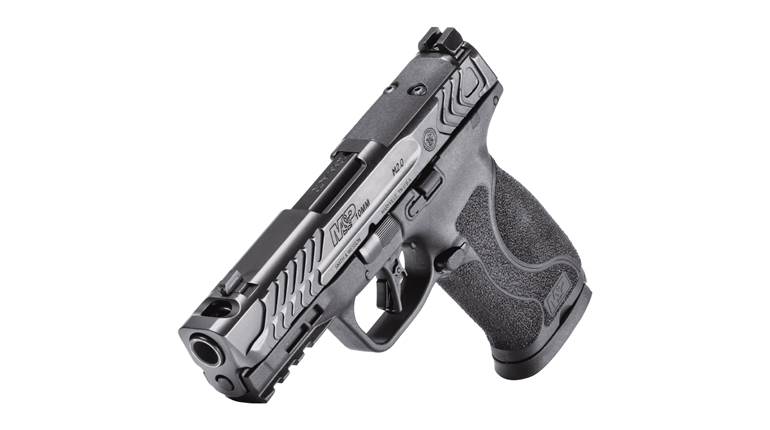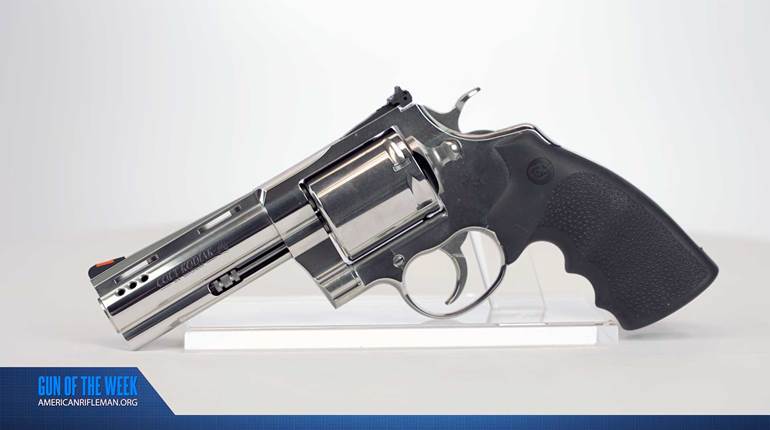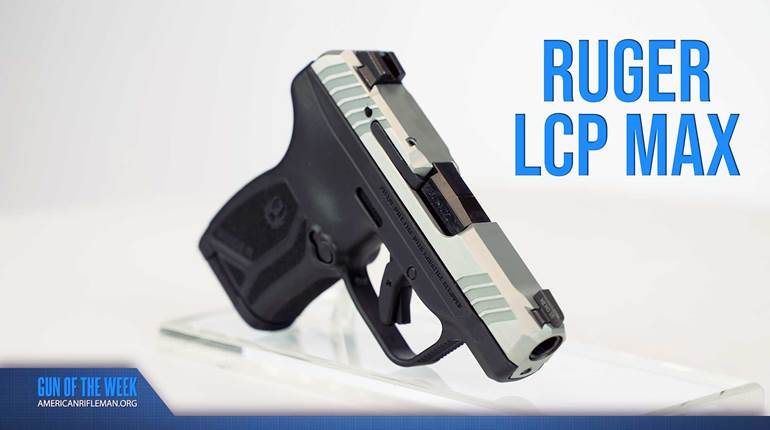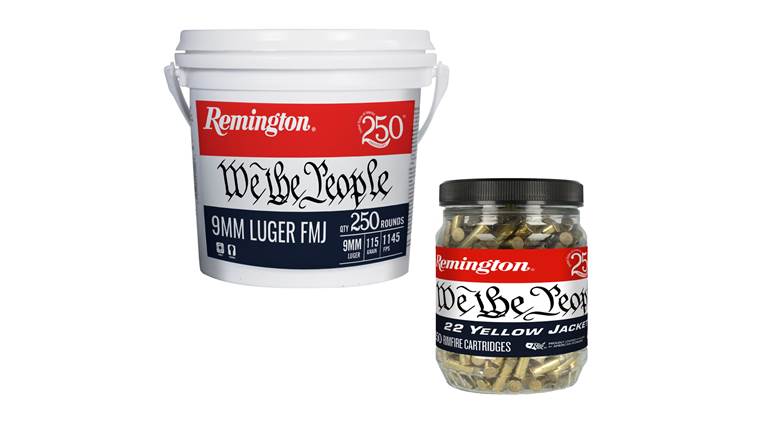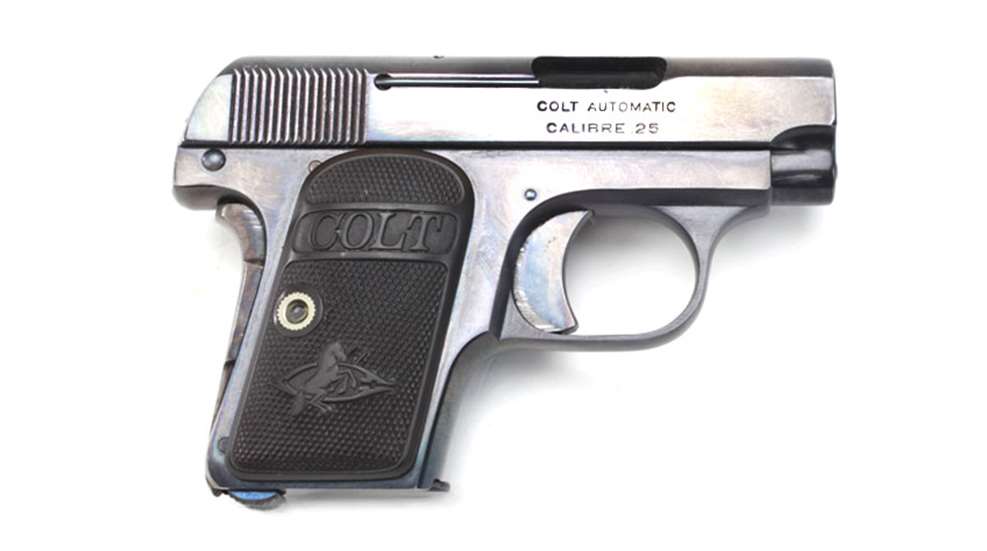
NRA Museum images
By 1904, a 39-year-old John Browning had designed no less than a great single-shot rifle, the Model 1885 Winchester, three lever-action rifles, the Models 1892, 1894 and 1895, a pump-action shotgun, the Model 1893, and several semi-automatic rifles and pistols—too numerous to list here. There’s a story floating around that Browning wanted a small pistol that could fit in his vest pocket as he tarried about his farm outside Ogden, Utah. Concurrently, he wanted to come up with the smallest center-fire cartridge that would use the small pistol primer and replicated the power of the ubiquitous .22 LR. 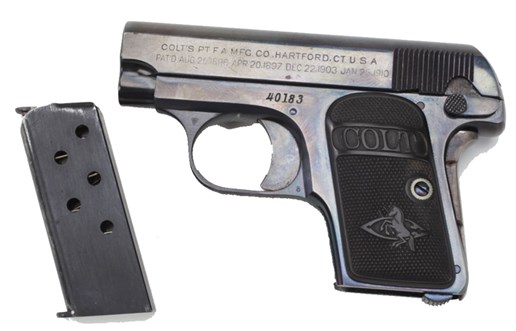
The nature of the pistol dictated that it would have to be of blowback design. Space requirements meant that a hammer—even an internal hammer like on the Model 1903 Colt—would not do. So Browning came up with an idea to eliminate the hammer. He separated the firing pin with an internal spring between the firing pin, proper, and a firing pin spring guide. The trigger was linked by a pin to a sear that engaged a point on the firing pin larger in diameter than the pin. Pulling the trigger disengaged the sear from the firing pin, allowing it to move forward under its spring tension and fire the primer. Thus, once again, John Browning provided another firearm innovation—the striker-fired pistol. Others had used the idea before—Borchardt’s 1893 pistol used a form of a striker under spring tension—but Browning’s design was the first to see widespread use. He also used a version of it in his Model 1910 pistol.
For his vest pocket pistol, the barrel had to be no longer than 2". In order to attain .22 LR performance, the bullet needed to be heavier than the standard .22 because it would be impossible to achieve rifle-like velocity in such an abbreviated barrel. He settled on a 50-gr. bullet in a .615”-long case with a head diameter of .302. To achieve all of those parameters, Browning settled on a .251”-diameter bullet—such a bullet has the same sectional density as a 40-gr., .22-cal. bullet—thus the .25 ACP was born.
Although Browning submitted the idea of the .25-cal. pocket pistol to Colt in 1904, the company did not accept the idea. Browning then pitched the concept to Fabrique Nationale, and that company jumped on it, issuing a pistol in 1906 based upon Browning’s design but with a few minor changes ushered in by Dieudonné Saive, an assistant to Browning when Browning was in Belgium, and who, coincidentally, later developed the FN 49 and FN-FAL rifles. The FN 1906, as it was known, eventually led to the 1927 Baby Browning, which is still being manufactured today. When Colt recognized the popularity of the diminutive pistol, they, too, brought it out in 1906 as the 1908 Vest Pocket, known inside the factory as the Model N.
Despite the cartridge’s notorious lack of power, the Vest Pocket model, as well as the FN 1906, posted brisk sales. Among the ballistically naïve, the notion of such a small, easily-concealable gat is so tempting, they ignore the fact that people shot with the cartridge very often, would become angry and resort to violent behavior. Their logic seems to be that no one wants to get shot with anything, which is probably true. Col. Jeff Cooper once opined that while the construction of the pistol may be fine—given Colt’s reputation for making robust and beautiful guns—about the only use for what would be commonly called the Colt .25 Auto would be as a watch fob.
Initially, the Vest Pocket model was equipped with two safeties, a slide-locking manual safety that also prevented the sear from disengaging and an integral grip safety. At somewhere between 139,000 and 140,000 produced pistols—around 1916—a third so-called safety was invented by Colt engineer George Tansley. That would be a magazine-disconnect safety that prevents the pistol from being fired without a magazine in place.
The Vest Pocket model was also one of the first to utilize what is now called the “gutter-snipe” slide sight. While the notion of sights on a pistol meant for very close shooting seemed—and is—useless, nonetheless the market of the day demanded some form of sighting on the pistol. The front sight is a typical tiny, half-moon, fixed sight; the slide has a round-bottom groove over its entire length save for a small part about 3/8" from the back of the slide with an even smaller notch. It’s doubtful that anyone whose eyesight isn’t phenomenal could even see these sights under the best conditions.
Fit and finish are typical Colt for the time. The all-steel pistol’s parts were polished brightly and given a deep bluing, save the trigger and manual safety which were color casehardened. Nickel plating was also a popular option. A few silver-plated guns were available by special order. Grips were hard rubber with the rampant Colt monogram, but checkered walnut, ivory and mother of pearl were also available. Quite a few Vest Pocket models were engraved either at the factory or by outside engravers since these pistols were often a gift.
During its 40-year run at Colt, some 420,705 copies were made, and as mentioned, its European cousin the Baby Browning from FN remains in production. There is some collector interest with pristine examples fetching north of $600 for blue and $850-plus for nickel-plated guns. Those with factory ivory or mother of pearl demand a bit more than a grand. If it is factory engraved and has an original box and paperwork, a 1908 Vest Pocket Model will lighten your wallet in the neighborhood of a couple of grand. It may not have the stopping power of the 1911, but its graceful profile reminiscent of its bigger brother the 1903 Model and the legendary Colt quality make the 1908 Vest Pocket Model a desired component of any serious Colt collection. That’s a high compliment for a pea shooter intended to fit in a watch pocket.
Additional Reading:
Sorting Out The Littlest Brownings
Pocket Pistols Past and Present
6 of the Smallest Handguns on the Market Today












